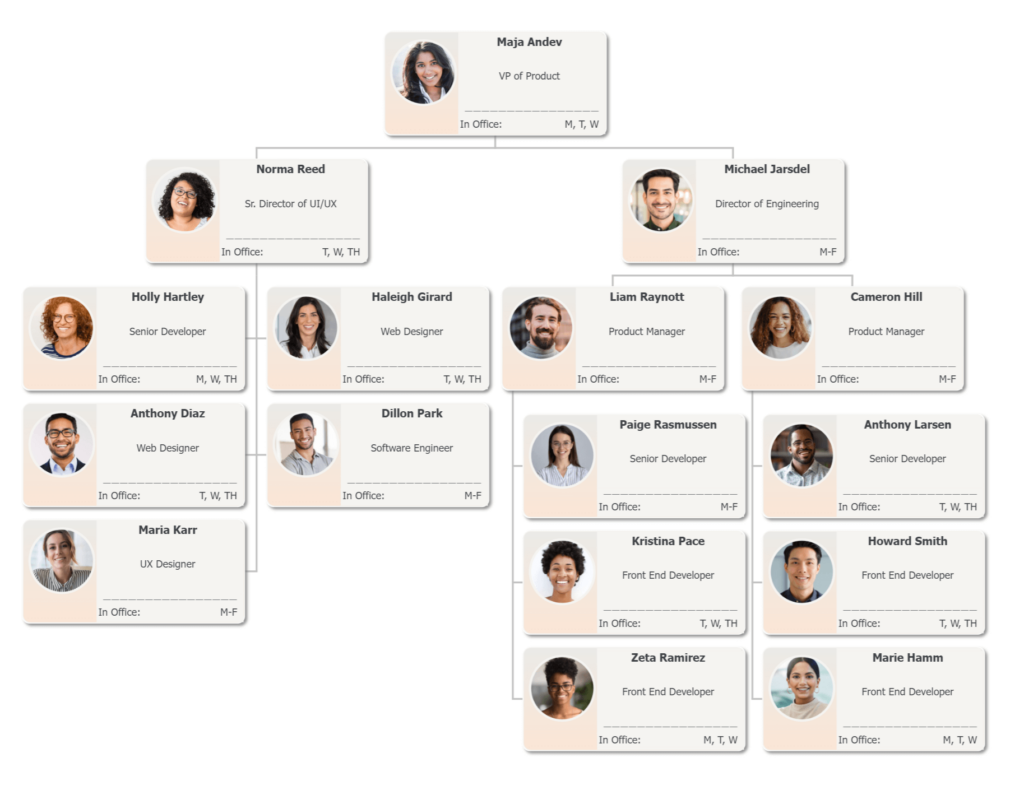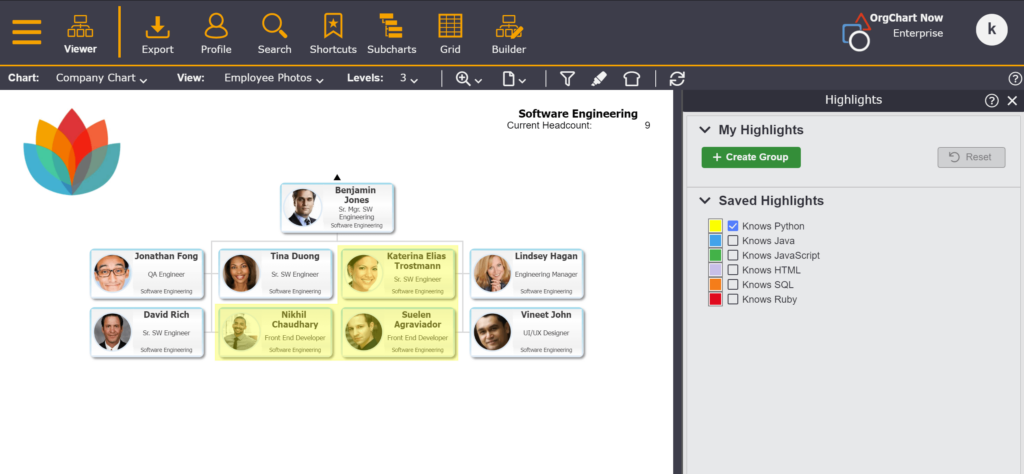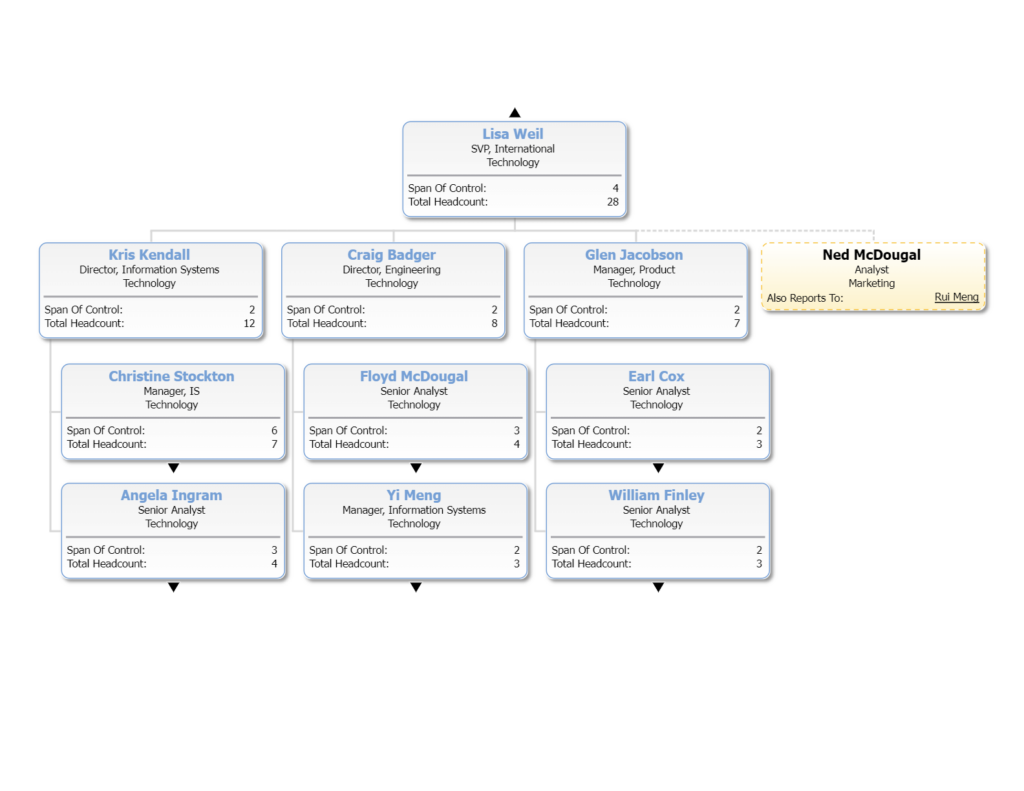June 7, 2023
1:08 PM
By OrgChart Team
Effective project management is critical to success across industries, from nonprofits and government agencies to higher education institutions. Org charts are powerful tools that can significantly improve project management by providing transparency, valuable insights, and a well-organized structure. In the McKinsey article, “Getting organizational redesign right” it states, “A well-designed organization ensures that the form of the organization matches its purpose or strategy.” This article, designed for HR professionals, explores the benefits and efficiencies org charts bring to project management and examines project management structures tailored to various industry needs.
Org charts represent an organization’s hierarchy, making identifying roles, responsibilities, and reporting lines easy. This transparency ensures everyone knows their tasks and whom to plan tasks with, increasing the chances they meet deadlines and produce high-quality results. McKinsey suggests that “redesigning the organization around roles, rather than individuals, helps to clarify responsibilities and accountabilities.” HR professionals can use org charts to track employee performance, manage succession planning, and align reporting structures with organizational goals.
HR professionals can use org charts to track employee performance, manage succession planning, and align reporting structures with organizational goals.
“Org charts are essential for fostering a sense of clarity and accountability within an organization, helping team members understand their roles and how they contribute to the company’s overall success,” says OrgChart CEO Tom McCarty.
A well-crafted org chart simplifies communication and collaboration by clearly defining team member relationships and responsibilities. Efficient communication speeds up decision-making and enables organizations to adapt quickly to changing circumstances. As McKinsey notes, “In rapidly changing environments, risk is reduced by shortening the time it takes for the organization to respond to change.”

Org charts are especially beneficial in remote or hybrid work environments, where clear communication is crucial. HR professionals can use org charts to identify communication bottlenecks, encourage cross-departmental collaboration, and streamline the onboarding process for new employees.
As CEO Tom McCarty points out, “Org charts are the backbone of effective communication within an organization, allowing for seamless collaboration across departments and making the onboarding process for new employees a smooth experience.”
Org charts provide a bird’s-eye view of an organization’s resources, helping project managers allocate tasks and manage workloads effectively. This promotes efficiency, prevents burnout, and reduces disengagement. HR professionals can use org charts to monitor employee workloads, pinpoint overburdened team members, and ensure fair distribution of tasks and responsibilities across the organization.

Org charts enable project managers to visualize an organization’s hierarchy and identify skills gaps and training needs. HR professionals use org charts to detect areas that require additional expertise or training and take proactive measures to bridge these gaps. By doing so, they foster a culture of continuous learning and professional growth, improving overall project outcomes and enhancing employee retention.
Choosing the proper project management structure is crucial for organizations across various industries. In “Revisiting the Matrix Organization” McKinsey emphasizes that “designing a ‘fit for purpose’ organization involves making choices about the best way to organize and the right capabilities to emphasize.” This section will explore different project management structures, such as functional, matrix, and projectized structures, to help HR professionals determine the best fit for their organizations.
The functional structure is common in organizations with well-defined departments and works well for department-specific projects. However, it may be less suitable for cross-functional projects requiring collaboration between multiple departments. HR professionals can use functional structures to align talent with departmental goals and develop a specialized workforce.
The helix structure is a modern organizational model emphasizing flexibility, adaptability, and cross-functional cooperation. According to McKinsey in “The Helix Organization” this structure “combines elements of the functional, matrix, and project-based models to create a more fluid, responsive organization.” This dynamic approach to organizational structure is particularly well-suited for rapidly changing industries and organizations that need to innovate and adapt efficiently.
Org charts can be instrumental in implementing a helix structure, clearly visualizing reporting lines and functional relationships. By streamlining communication and collaboration within the helix structure, org charts empower organizations to respond rapidly to changes in their industry landscape.

The matrix structure promotes collaboration across departments, making it ideal for complex, cross-functional projects. However, it may also create confusion and potential conflicts of interest due to dual reporting lines. HR professionals can address these challenges by implementing clear communication guidelines and conflict resolution strategies, ensuring smooth project execution and a harmonious work environment.
A projectized structure is ideal for organizations primarily focusing on project-based work, providing greater flexibility and adaptability. However, it may not be suitable for organizations with strong departmental divisions or those requiring a more stable structure. HR professionals can support a projectized structure by recruiting and retaining versatile talent capable of adapting to various project demands.
Incorporating org charts into project management effectively enhances communication, collaboration, and efficiency across various industries. By providing a clear understanding of team hierarchy and roles, org charts foster improved decision-making, resource allocation, and overall project success. HR professionals play a crucial role in leveraging org charts to streamline talent management, optimize resource allocation, and drive success in their industry.
Supercharge your project management capabilities and achieve your organizational goals by leveraging OrgChart. OrgChart’s cutting-edge automation software integrates seamlessly with HR and applicant-tracking information systems, generating professional, tailor-made organizational charts. OrgChart empowers organizations to stay agile and responsive, driving growth and success.
Remember, the key to successful project management is staying organized and adapting to changes in the business landscape. Use OrgChart to create a strong foundation for your organization and set yourself on the path to success.
Tags: